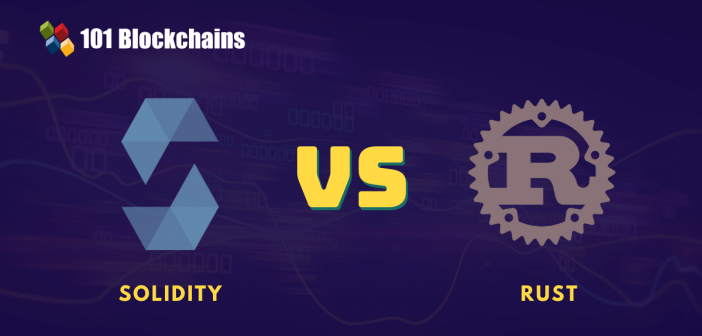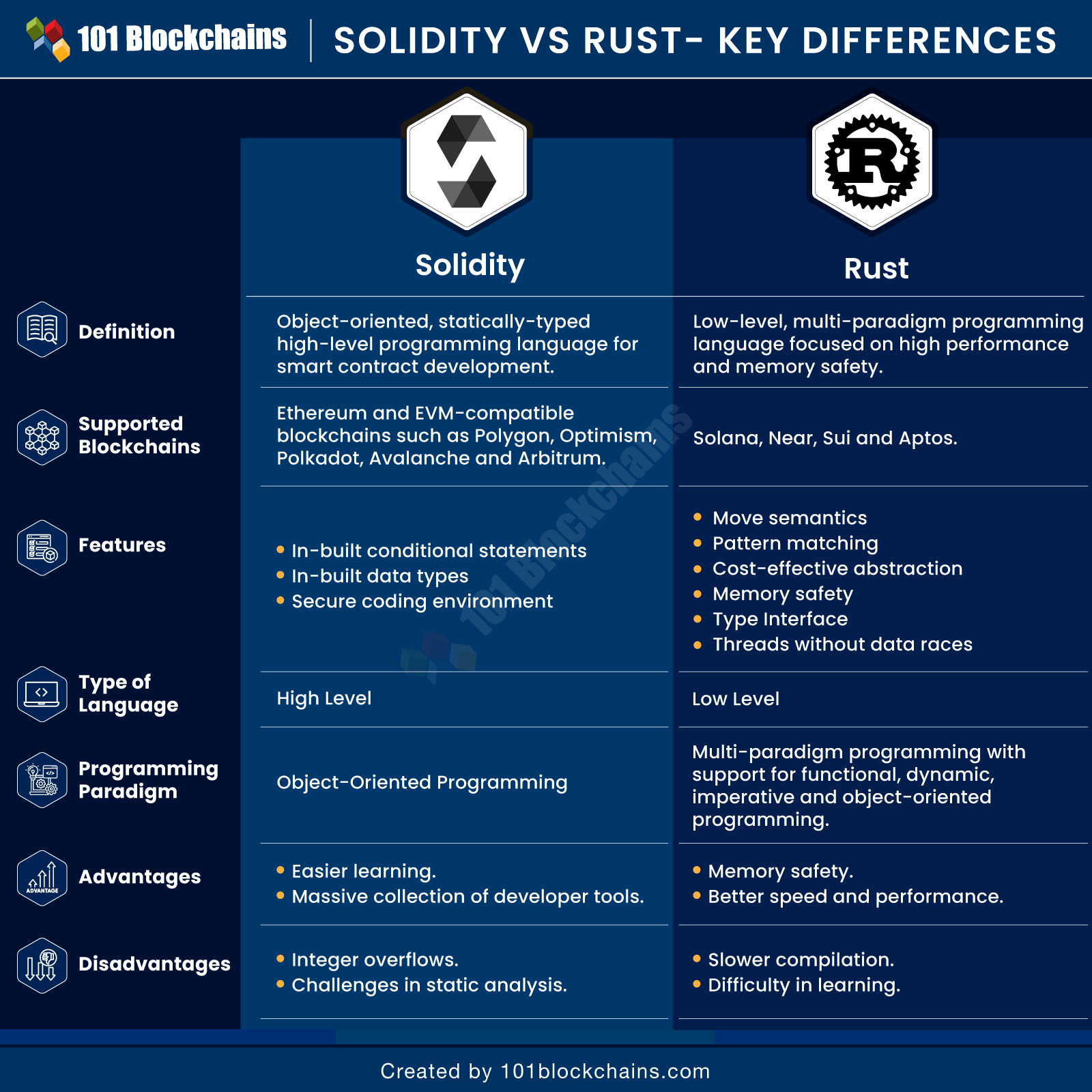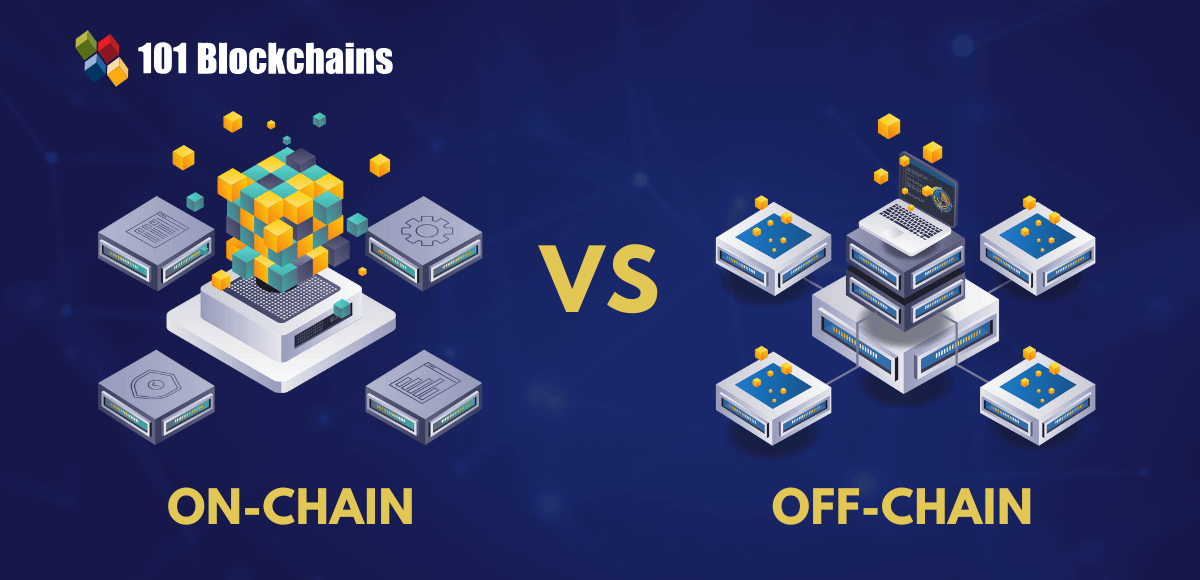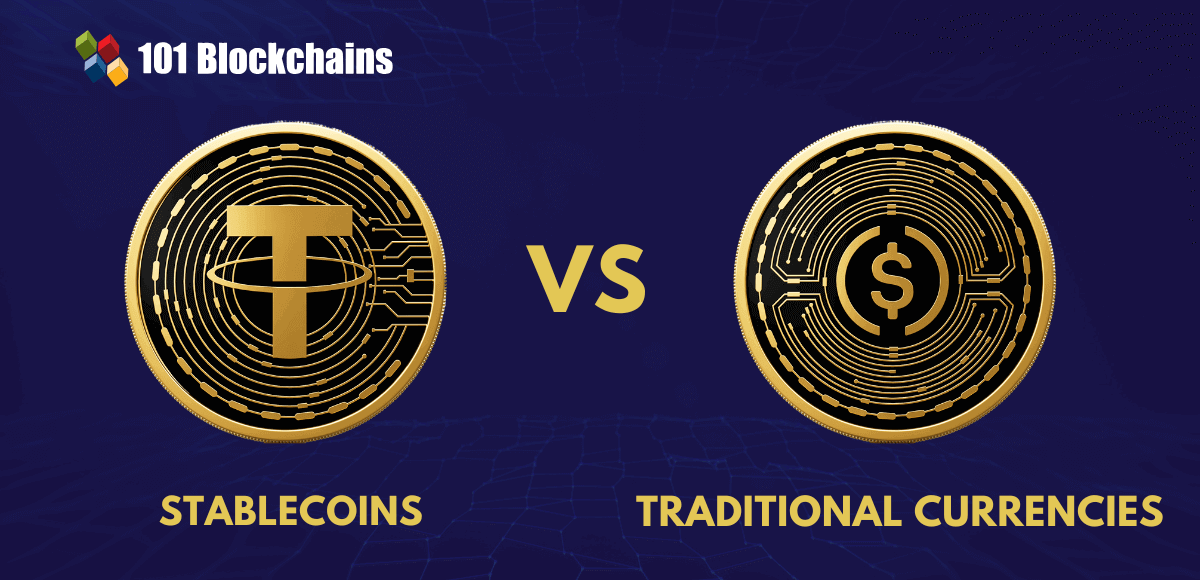Learn how blockchain truly works, master key definitions, and uncover what makes smart contracts so "smart." Dive into the fundamentals, gain valuable insights, and start your blockchain journey today!

- Comparisons
Georgia Weston
- on March 01, 2023
Solidity vs. Rust: Key Differences
The fast pace of growth in blockchain development activity calls for the effective selection of developer tools. What is the most important thing a developer needs for creating blockchain or web3 solutions? The answer would point to smart contract development languages such as Solidity and Rust. Now, the Solidity vs Rust comparison is an important requirement for developers before finalizing a particular choice for smart contract development.
Solidity is the popular choice for developing decentralized applications on the Ethereum Virtual Machine or EVM. On the other hand, Rust is the top priority for developers working on dApp projects based on the Solana blockchain. Both programming languages have distinct advantages and setbacks in comparison to each other. Let us find out the differences between Solidity and Rust in the following post.
Are you aspiring to learn the fundamentals of the Ethereum Virtual Machine and smart contracts’ upgradability? Enroll now in the Advanced Solidity Development Course.
Fundamentals of Solidity and Rust
Before you develop a detailed Rust vs Solidity comparison, it is important to understand the fundamentals of both languages. The basic definition of both languages, their traits, and supported blockchains could offer a strong foundation for drawing out comparisons between them.
Solidity Fundamentals
The first player in the difference between Solidity and Rust, i.e., Solidity, is an object-oriented, statically-typed high-level programming language. It is the popular choice among programming languages for the implementation of smart contracts on the Ethereum blockchain and EVM-compatible blockchain networks.
- The object-oriented programming approach emphasizes data and objects rather than logic and functions in smart contract development.
- In addition, the statically-typed trait of Solidity ensures the identification of different types of errors during the time of compilation.
- The classification of Solidity as a high-level language implies the user-friendly nature of software development without depending on hardware architecture.
Solidity has been tailored for running on the EVM, a runtime environment that serves as a virtual machine for running software programs or smart contracts. Apart from Ethereum, some of the notable blockchain networks which support Solidity include Polygon, Avalanche, Polkadot, Optimism and Arbitrum.
Want to get an in-depth understanding of Solidity concepts? Enroll now in Solidity Fundamentals Course
Notable Features of Solidity
The answers to questions like “Is Solidity better than Rust?” would focus on the characteristic traits of Solidity. Here are the notable features of Solidity which make it a popular choice for smart contract development.
-
In-Built Functionalities
Solidity does not require developers to create conditional statements for performing actions that depend on specific conditions. On the contrary, developers could specify the conditional statements in the source code itself. Subsequently, the code would execute specific actions upon fulfillment of predefined conditions.
-
In-Built Data Types
The responses for “Which is best Solidity or Rust?” would also refer to the traits of Solidity, such as in-built data types. Solidity offers in-built support for common data types such as integers, strings, floating point numbers, and arrays. In addition, developers could also define custom data types for smart contract development.
-
Safe Development Environment
The next noticeable highlight in the features of Solidity refers to the safety in the coding environment. Solidity compiler verifies the code for identifying errors at the time of scripting alongside alerting developers about expected problems. As a result, Solidity can support efficient coding practices in the case of dApps with large and complicated programming logic.
Excited to learn about the key elements of Solidity? Check the presentation now on Introduction To Solidity
Rust Fundamentals
The second player in the Solidity vs Rust debate, i.e., Rust, is a low-level, multi-paradigm programming language. Rust emphasizes performance and types of safety to ensure the development of high-performance and robust applications.
- As a low-level programming language, Rust features the same architecture as a computer’s processor. Therefore, it can help in scripting high-performance and machine-efficient code.
- On the other hand, the multi-paradigm nature of Rust offers support for different programming styles, including functional, procedural, and dynamic approaches.
The answers to “Is Solidity better than Rust?” would draw attention to how Rust serves as a core programming language on the Solana blockchain. In addition, other smart contract-based blockchains such as Sui, Near, and Aptos support Rust programming language.
Excited to know about the best programming languages in the field of web3? Check the detailed guide Now on List Of Top Web3 Programming Languages
Notable Features of Rust
You can find reliable answers to “Which is best Solidity or Rust?” by understanding the unique features of Rust. The programming language features similarities to C++, albeit with memory safety and compile-time type safety. In addition, the benefits of concurrency and a comprehensive set of libraries and tools support efficient programming workflows. Here is an outline of the prominent features you can find in Rust programming language.
-
Type Interface
The type interface feature of Rust is a unique highlight in programming languages, which ensures the automatic typing of an expression.
-
Threads without Data Races
The threads without data races feature come with a specific set of rules. As a result, ownership transmission happens only between owners of different objects and dissimilar threads.
-
Cost-effective Abstraction
The Rust vs Solidity comparison must also emphasize how Rust enables zero-cost abstraction. Developers can add abstraction in Rust programming logic without affecting the runtime performance of the concerned code. As a result, it could help in improving the readability and quality of code without any runtime performance costs.
-
Memory Safety
One of the significant highlights of Rust’s programming language points to memory safety. Rust can ensure memory safety according to the ownership system. In the case of Rust programs, variables take care of ownership and management of memory space. At the same time, other variables can also carry off memory space temporarily for a specific duration of time. Therefore, Rust could ensure memory safety during compilation without the need to rely on garbage collection to track the objects.
-
Move Semantics
The difference between Solidity and Rust is also evident in the facility of move semantics feature in Rust programming language. Move semantics involves replacing a copy operation for a move operation in cases where the source object is temporary.
-
Pattern Matching
Another distinct feature in Rust is the pattern matching functionality, which enables access to Rust patterns in combination with match expressions. Pattern matching helps in establishing better command over the control flow of programs. The common pattern combinations in Rust programming language include variables, arrays, placeholders, and wildcards.
Master the art of Smart Contract development with Solidity to create innovative web3 applications for diverse use cases as a Solidity expert with Solidity Skill Path
Comparison between Solidity and Rust
The detailed overview of Solidity and Rust fundamentals provide the ideal foundation for a Solidity vs Rust comparison. Interestingly, you should also learn about the differences as well as similarities between both languages to identify the ideal choice for your desired requirements. Furthermore, the comparison between the two programming languages could also include a relative evaluation of each language against the other. Let us learn about the similarities, differences, and comparative advantages of Solidity and Rust.
Here is an overview of the difference between Solidity and Rust in the form of a table.

Please include attribution to 101blockchains.com with this graphic. <a href='https://101blockchains.com/blockchain-infographics/'> <img src='https://101blockchains.com/wp-content/uploads/2023/02/Solidity-vs-Rust-Key-Differences.png' alt='Solidity vs Rust='0' /> </a>
Similarities between Rust and Solidity
Many people searching for answers to “Is Solidity better than Rust?” do not have any idea of similarities between them. The two most important similarities between Solidity and Rust include Turing completeness and multichain compatibility.
Both the programming languages are Turing complete, thereby ensuring an effective solution for computation problems, irrespective of complexities.
On the other hand, the multichain compatibility ensures that the languages support programming on multiple blockchain networks. Solidity was initially designed for Ethereum. However, it also supports layer 2 blockchains, modular blockchains, and sidechains alongside EVM-compatible layer 1 blockchain. Rust also provides support for different blockchain networks, such as Solana and Near. In addition, Rust also offers an implementation based on the substrate framework of Polkadot.
Excited to learn the basic and advanced concepts of ethereum technology? Enroll Now in Ethereum Technology Course
Differences between Solidity and Rust
The actual answers to “Which is best Solidity or Rust?” would turn towards the prominent differences between both programming languages. The primary differences between Solidity and Rust focus on the type of languages and the programming approaches. Let us go through a detailed face-to-face comparison between Solidity and Rust.
-
Type of Language
The foremost point of difference between Solidity and Rust would refer to the type of language. Solidity is a high-level programming language that can provide a higher level of abstraction with reference to the computer system architecture. As a result, Solidity presents easier options for learning and using the programming language.
On the other hand, Rust is a low-level programming language featuring multiple similarities with the computer hardware architecture. Therefore, it can guarantee better speed and memory efficiency, which makes it a machine-oriented language.
-
Programming Styles
The programming paradigm is another vital parameter in Rust vs Solidity comparisons. Programming paradigms refer to the style or approach followed for solving a specific problem through programming logic. Solidity follows an object-oriented approach to solving problems with smart contract logic.
On the other side of the comparison, Rust features a multi-paradigm programming approach. As a result, it can facilitate flexibility in the adoption of multiple paradigms for creating programming logic. Rust supports many popular programming paradigms, such as object-oriented as well as functional, imperative, and dynamic approaches.
Curious to understand the complete smart contract development lifecycle? Enroll in Smart Contracts Development Course Now!
-
Comparison of Advantages
The comparison between Solidity and Rust should also emphasize the difference in advantages of both languages. You can expand the Solidity vs Rust debate with valuable insights by verifying how development in one programming language is better than in the other.
The foremost advantages of creating dApps with Rust focus on memory safety alongside better speed and high performance. Memory safety helps developers in avoiding memory-related errors. The rust programming language offers the assurance of memory safety by leveraging the principle of borrowing and ownership.
It could ensure memory safety through the elimination of memory-related errors during compilation. The responses to “Is Solidity better than Rust?” can find new directions with the assurance of high speed and performance in Rust. Developers could use Rust to create decentralized programs with the facility of high speed and performance without relying on garbage collection.
The Rust vs Solidity comparison in terms of benefits would turn in favor of Solidity with the advantage of easier learning and collection of developer tools. Solidity is a high-level programming language, thereby ensuring that the code is readable and beginners can understand the code.
The similarity of Solidity syntax to that of JavaScript ensures that developers with prior programming experience can learn the language with ease. In addition, Solidity brings a treasure of developer tools with the support of platforms such as OpenZeppelin, which can provide open-source libraries for smart contract development with high security. On top of it, Solidity also offers IDEs such as Hardhat and Remix browser-based IDE.
-
Comparison of Tradeoffs
The advantages of Solidity and Rust offer a better impression of which programming language you should choose for dApp development. However, the difference between Solidity and Rust should also compare the tradeoffs with each language against the other.
The most noticeable tradeoffs in using Rust over Solidity for dApp development include the slow compilation and difficulty in learning. Rust relies on the low-level virtual machine or LLVM architecture for generating code. In the case of large projects, program compilation could take more than 10 minutes.
On the other hand, the Solidity vs Rust debate also outlines the challenges of learning Rust programming. For example, developers have to struggle with concepts of the ownership and borrowing system. Furthermore, Rust programs also require the creation of the complete codebase from scratch.
On the other side of the comparison, Solidity also brings a fair share of setbacks in comparison to Rust. The integer overflow problem is a common issue in previous versions of Solidity before Solidity 0.8. Another problem with Solidity refers to the difficulty in performing static analysis owing to the Turing complete nature of Solidity.
Start learning Blockchain with World’s first Blockchain Skill Paths with quality resources tailored by industry experts Now!
Final Words
The detailed comparison between Solidity and Rust showcases that both of them have unique features and challenges. Solidity is the popular choice for smart contract development since it is the core language of Ethereum. On the other hand, Rust is the core language of Solana, the emerging competitor of Ethereum.
The Solidity vs Rust comparison also outlines how you can have specific advantages and disadvantages by choosing one over the other. Ultimately, the choice of a programming language depends on your desired use cases and the specific features you need. Learn more about Solidity and Rust programming to find out more practical differences between them.
*Disclaimer: The article should not be taken as, and is not intended to provide any investment advice. Claims made in this article do not constitute investment advice and should not be taken as such. 101 Blockchains shall not be responsible for any loss sustained by any person who relies on this article. Do your own research!





